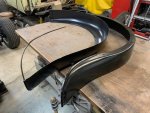Thought I would post up this job. I'm making these fenders 2 1/2 inches wider for a 34 Ford truck. Nice brand new reproduction fenders, and I cut them in two pieces. Hope they look as good once they're done.
I bought this 6 foot long flexible steel ruler at Bianca Amor's junk store for a couple bucks. Works great for laying out cut and scribe lines. Found the middle of the crown, about 4 3/4 inches from the inboard edge. Clamped it in place, scribed it, and cut it, except for the wire inside the edge of the fender. I'll extend the end of the wire, so there is only one weld there, as they are prone to breakage, as we all know. I'll bend it to follow the new bottom shape once the patches are tacked in place. Lots of clamps so the fit will be precise along every inch the seam.



I bought this 6 foot long flexible steel ruler at Bianca Amor's junk store for a couple bucks. Works great for laying out cut and scribe lines. Found the middle of the crown, about 4 3/4 inches from the inboard edge. Clamped it in place, scribed it, and cut it, except for the wire inside the edge of the fender. I'll extend the end of the wire, so there is only one weld there, as they are prone to breakage, as we all know. I'll bend it to follow the new bottom shape once the patches are tacked in place. Lots of clamps so the fit will be precise along every inch the seam.


